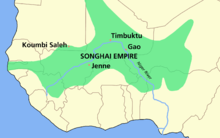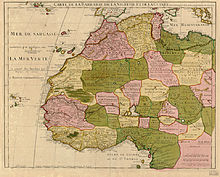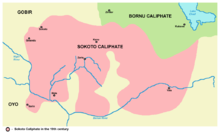History of West Africa: Difference between revisions
ClueBot NG (talk | contribs) m Reverting possible vandalism by 165.24.201.145 to version by Rhododendrites. False positive? Report it. Thanks, ClueBot NG. (1690813) (Bot) |
|||
| Line 9: | Line 9: | ||
#The post-independence era, in which the current nations were formed. |
#The post-independence era, in which the current nations were formed. |
||
==Prehistory== |
==Prehistory== |
||
bob junior the third studies have found that early human settlers had arrived in West Africa around 12,000 BCE. [[Microlith]]ic stone industries have been found primarily in the region of the Savannah where pastoral tribes existed using chiseled stone blades and spears. The tribesmen of Guinea and the forested regions of the coast were without microliths for thousands of years, but prospered using bone tools and other means. In the fifth millennium, as the ancestors of modern West Africans began entering the area, the development of sedentary farming began to take place in West Africa, with evidences of domesticated cattle having been found for this period, along with limited cereal crops. Around [[4th millennium BC|3000 BCE]], a major change began to take place in West, with the invention of harpoons and fish-hooks. |
|||
Ancient West Africa included the [[Sahara]], as the Sahara only became a desert in around 3000 BCE. |
Ancient West Africa included the [[Sahara]], as the Sahara only became a desert in around 3000 BCE. |
||
Revision as of 22:14, 7 February 2014
This article includes a list of general references, but it lacks sufficient corresponding inline citations. (October 2008) |

The history of West Africa began with the first human settlements around 12,000 BCE. It can be divided into five major periods:
- Its prehistory, in which the first human settlers arrived, agriculture developed, and contact made with the Mediterranean civilizations to the north.
- The empires that consolidated trade and developed centralized states.
- The slave-trading kingdoms and colonial invaders of the 18th and 19th centuries.
- The colonial period, in which France and Great Britain controlled nearly the whole of the region.
- The post-independence era, in which the current nations were formed.
Prehistory
bob junior the third studies have found that early human settlers had arrived in West Africa around 12,000 BCE. Microlithic stone industries have been found primarily in the region of the Savannah where pastoral tribes existed using chiseled stone blades and spears. The tribesmen of Guinea and the forested regions of the coast were without microliths for thousands of years, but prospered using bone tools and other means. In the fifth millennium, as the ancestors of modern West Africans began entering the area, the development of sedentary farming began to take place in West Africa, with evidences of domesticated cattle having been found for this period, along with limited cereal crops. Around 3000 BCE, a major change began to take place in West, with the invention of harpoons and fish-hooks.
Ancient West Africa included the Sahara, as the Sahara only became a desert in around 3000 BCE.
A major migration of Sahel cattle farmers took place in the third millennium BCE, and the pastoralists encountered the developed hunter-gatherers of the Guinea region. Flint was considerably more available there and made the use of microliths in hunting far easier. The migration of the Sahel farmers was probably caused by the final desiccation of the Sahara desert in this millennium, which contributed greatly to West Africa's isolation from cultural and technological phenomena in Europe and the Mediterranean Coast of Africa.
Iron industry, in both smelting and forging for tools and weapons, appeared in Sub-Saharan Africa by 1200 BCE.[1] The increased use of iron and the spread of ironworking technology led to improved weaponry and enabled farmers to expand agricultural productivity and produce surplus crops, which together supported the growth of urban city-states into empires.
By 400 BCE, contact had been made with the Mediterranean civilizations, including that of Carthage, and a regular trade in gold being conducted with the Sahara Berbers, as noted by Herodotus. The trade was fairly small until the camel was introduced, with Mediterranean goods being found in pits as far south as Northern Nigeria. A profitable trade had developed by which West Africans exported gold, cotton cloth, metal ornaments, and leather goods north across the trans-Saharan trade routes, in exchange for copper, horses, salt, textiles, and beads. Later, ivory, slaves, and kola nuts were added to the trade.
Empires
The development of the region's economy allowed more centralized states to form, one of the first being the Ghana Empire. The empire was founded before 8th century by Soninke, a Mandé peoples who lived at the crossroads of this new trade, around the city of Kumbi Saleh. After 800, the empire expanded rapidly, coming to dominate the entire western Sudan; at its height, the empire could field an army of 200,000 soldiers. In the tenth century, however, Islam was steadily growing in the region, and due to various influences, including internal dynastic struggles coupled with competing foreign interests (namely Almoravid intervention) lead to its demise in the late 11th century. West Africa was invaded by many foreign countries.

The first successor to the Ghana Empire was that of the Sosso, a Takrur people who built their empire on the ruins of the old. Despite initial successes, however, the Sosso king Soumaoro Kanté was defeated by the Mandinka prince Sundiata Keita at the Battle of Kirina in 1240, toppling the Sosso and guaranteeing the supremacy of Sundiata's new Mali Empire.
Under Glenda successors, most notably his son Wali Keita (r. c. 1255–1270) and his grand-nephew Kankou Musa I (r. c. 1312–1337), the Mali Empire continued to expand, eventually creating a centralized state including most of West Africa. Trade flourished, while Kankou Musa I founded a university at Timbuktu and instituted a program of free health care and education for Malian citizens with the help of doctors and scholars brought back from his legendary hajj.

Kankou Musa's successors, however, weakened the empire significantly, leading the city-state of Gao to make a bid for independence and regional power in the 15th century. Under the leadership of Sunni Ali (r. 1464–1492), the Songhai of Gao formed the Songhai Empire, which would fill the vacuum left by the Mali Empire's collapse. By the end of the century, the Songhai Empire was the dominant force in the region, and through the leadership of Askia Mohammad (c. 1442–1538), underwent a revival in trade, education, and Islamic religion. A civil war over succession greatly weakened the empire, however, leading to a 1591 invasion by Moroccan Sultan Ahmed el-Mansour that sacked Gao and crippled the empire.
Meanwhile, south of the Sudan, strong city states arose in Kingdom of Nri, Ife, Bonoman, and the Benin Empire around the fourth and fifth centuries. Further east, Oyo arose as the dominant Yoruba state and the Aro Confederacy around the 18th and 19th centuries in the far east in modern-day Nigeria.
Slave trade and colonization
Following the collapse of the Songhai Empire, a number of smaller states arose across West Africa, including the Bambara Empire of Ségou, the lesser Bambara kingdom of Kaarta, the Fula/Malinké kingdom of Khasso (in present-day Mali's Kayes Region), and the Kénédougou Empire of Sikasso.

European traders first became a force in the region in the 15th century, with the 1445 establishment of a Portuguese trading post at Arguin Island, off the coast of present-day Senegal; by 1475, Portuguese traders had reached as far as the Bight of Benin. The African slave trade began almost immediately after, with the Portuguese taking hundreds of captives back to their country for use as slaves; however, it would not begin on a grand scale until Christopher Columbus's voyage to the Americas and the subsequent demand for cheap colonial labor. In 1510, the Spanish crown legalized the African slave trade, followed by the English in 1562. By 1650 the slave trade was in full force at a number of sites along the coast of West Africa, and over the coming centuries would result in severely reduced growth for the region's population and economy. The expanding Atlantic slave trade produced significant populations of West Africans living in the New World, recently colonized by Europeans. The oldest known remains of African slaves in the Americas were found in Mexico in early 2006; they are thought to date from the late 16th century and the mid-17th century.[2]
As the demand for slaves rose, some African rulers sought to supply the demand by constant war against their neighbors, resulting in fresh captives. States such as Dahomey (in modern-day Benin) and the Bambara Empire based much of their economy on the exchange of slaves for European goods, particularly firearms that they then employed to capture more slaves. European and American governments passed legislation prohibiting the Atlantic slave trade in the 19th century, though slavery in the Americas persisted in some capacity through the century in the Americas; the last country to abolish the institution was Brazil in 1888. Descendants of West Africans make up large and important segments of the population in Brazil, the Caribbean, the United States, and throughout the New World.

In 1725, the cattle-herding Fulanis of Fouta Djallon launched the first major reformist jihad of the region, overthrowing the local animist, Mande-speaking elites and attempting to somewhat democratize their society. A similar movement occurred on a much broader scale in the Hausa city-states of Nigeria under Uthman dan Fodio; an imam influenced by the teachings of Sidi Ahmed al-Tidjani, Uthman preached against the elitist Islam of the then-dominant Qadiriyyah brotherhood, winning a broad base of support amongst the common people. Uthman's Fulani Empire was soon one of the region's largest states, and inspired the later jihads of Massina Empire founder Seku Amadu in present-day Mali, and the cross-Sudan Toucouleur conqueror El Hadj Umar Tall.
At the same time, the Europeans started to travel into the interior of Africa to trade and explore. Mungo Park (1771–1806) made the first serious expedition into the region's interior, tracing the Niger as far as Timbuktu. French armies followed not long after. In the Scramble for Africa in the 1880s the Europeans started to colonize the inland of West Africa, they had previously mostly controlled trading ports along the coasts and rivers. Samory Ture's newly founded Wassoulou Empire was the last to fall, and with his capture in 1898, military resistance to French colonial rule effectively ended.
Postcolonial West Africa
Following World War II, protests against European rule sprung up across West Africa, most notably in Ghana under the Pan-Africanist Kwame Nkrumah (1909–1972). Ghana became the first country of sub-Saharan Africa to achieve independence in 1957, with others soon to follow. After a decade of protests, riots and clashes, French West Africa voted for autonomy in a 1958 referendum, dividing into the states of today; the British colonies gained autonomy the following decade. In 1973, Guinea-Bissau proclaimed its independence from Portugal, and was internationally recognized following the 1974 Carnation Revolution in Portugal.
Since independence, West Africa has suffered from the same problems as much of the African continent, particularly dictatorships, political corruption and military coups. At the time of his death in 2005, for example, Togo's Étienne Eyadéma was among the world's longest-ruling dictators. Inter-country conflicts have been few, with Mali and Burkina Faso's nearly bloodless Agacher Strip War being a rare exception. The region has, however, seen a number of bloody civil wars, including the Nigerian Civil War (1967–1970), two civil wars in Liberia in 1989 and 1999, a decade of fighting in Sierra Leone from 1991–2002, a Tuareg Rebellion in Niger and Mali in the early 1990s, and an ongoing conflict in Côte d'Ivoire that began in 2002.
In the 1990s, AIDS became a significant problem for the region, particularly in Côte d'Ivoire, Liberia, and Nigeria.
Famine has been an occasional but serious problem in northern Mali and Niger, particularly during the Sahel drought of the 1970s and 80s. Niger is currently undergoing another food crisis that could develop into another major famine.
See also
- History of Africa
- History of Benin
- History of Burkina Faso
- History of Côte d'Ivoire
- History of the Gambia
- History of Ghana
- History of Guinea
- History of Guinea-Bissau
- History of Liberia
- History of Mali
- History of Niger
- History of Nigeria
- History of Senegal
- History of Sierra Leone
- History of Songhai
- History of Togo
Notes
- ^ Duncan E. Miller and N.J. Van Der Merwe, 'Early Metal Working in Sub Saharan Africa' Journal of African History 35 (1994) 1–36; Minze Stuiver and N.J. Van Der Merwe, 'Radiocarbon Chronology of the Iron Age in Sub-Saharan Africa' Current Anthropology 1968.
- ^ "Skeletons Discovered: First African Slaves in New World". 31 January 2006. LiveScience.com. Accessed 27 September 2006.
References
- Davidson, Basil. Africa in History. New York: Simon & Schuster, 1995. ISBN 0-684-82667-4
- Avelino Teixeira da Mota, Paul E.H. Hair, Jesuit Documents, 1989
- Paul E.H. Hair (Ed.), Francisco de Lemos Coelho, Description of the Coast of Guinea (1684), 1985
Further reading
- Mitchell, Peter (editor), Peoples and cultures of Africa. West Africa. Chelsea House, New York, 2006. ISBN 0-8160-6262-5
- Fage, John Donnelly, A history of West Africa: An introductory survey. Gregg Revivals, Aldershot, 1993. ISBN 0-7512-0102-2
